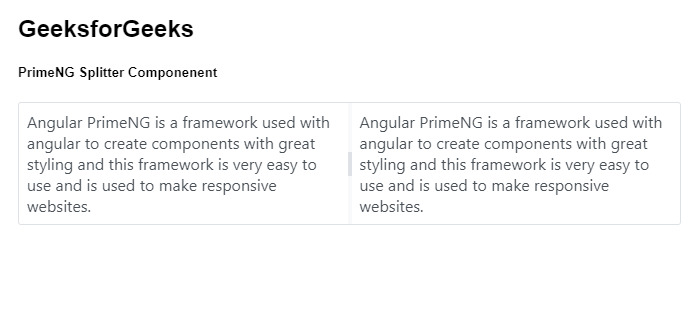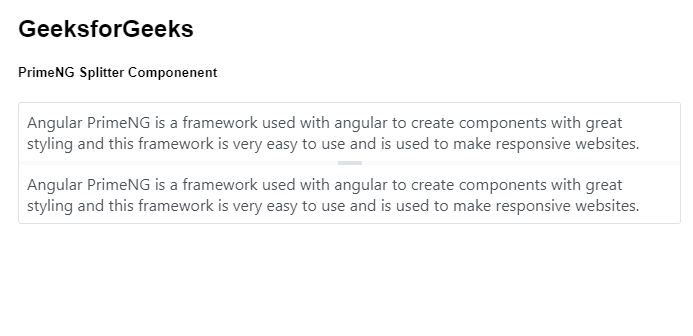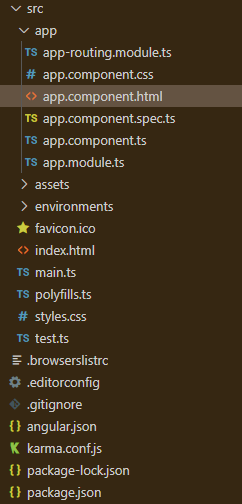Angular PrimeNG Splitter组件
Angular PrimeNG是一个开源框架,拥有丰富的原生Angular UI组件,这些组件被用来做很好的造型,这个框架被用来做响应式网站,非常容易。在这篇文章中,我们将了解如何在Angular PrimeNG中使用Splitter组件。我们还将学习属性、事件和造型,以及在代码中使用的语法。
分割器组件:它允许用户使用分割器分割两个元素,并分别利用它和调整面板大小。
属性:
- panelSizes。它用于指定面板的大小。它是数字数据类型,默认值为空。
- minSizes:它用于指定元素的最小尺寸。它是数字数据类型,默认值为空。
- 布局。它用于设置面板的方向。它是字符串数据类型,默认值为水平。
- gutterSize。它用于指定分割线的尺寸,单位为像素。它是数字数据类型,默认值是4。
- stateKey。它用于指定一个有状态的分割器的存储标识符。它是字符串数据类型,默认值为空。
- stateStorage。它用于定义一个有状态的分割器保持其状态的地方。它是字符串数据类型,默认值是session。
- style。它用于指定组件的内联风格。它是对象数据类型,默认值为空。
- styleClass。它用于指定组件的风格类别。它的数据类型为字符串,默认值为空。
- panelStyleClass。它用于指定面板的风格类别。它是字符串数据类型,默认值为空。
- panelStyle。它用于指定面板的内联风格。它是对象数据类型,默认值为空。
事件:
- onResizeStart。它是一个回调,在调整大小开始时被触发。
- onResizeEnd: 这是一个回调,在调整大小结束时被触发。
样式:
- p-splitter。它是容器元素。
- p-splitter : 它是调整大小时的容器元素。
- p-splitter-horizontal : 它是一个具有水平布局的容器元素。
- p-splitter-vertical:它是具有垂直布局的容器元素。
- p-splitter-panel : 它是分割器面板元素。
- p-splitter-gutter。它是调整面板大小时使用的沟槽元素。
- p-splitter-gutter-handle。它是水沟的手柄元素。
创建Angular应用程序和模块安装。
- 第1步:使用以下命令创建一个Angular应用程序。
ng new appname
- 第2步:在创建你的项目文件夹即appname后,使用以下命令移动到它。
cd appname
- 第3步:在你给定的目录中安装PrimeNG。
npm install primeng --save
npm install primeicons --save
项目结构。它将看起来像以下。
例子1:这是一个基本的例子,说明了如何使用分割器组件。
<h2>GeeksforGeeks</h2>
<h5>PrimeNG Splitter Component</h5>
<p-splitter>
<ng-template pTemplate>
<div class="p-col p-ai-center p-jc-center">
Angular PrimeNG is a framework used with angular
to create components with great styling and this
framework is very easy to use and is used to make
responsive websites.
</div>
</ng-template>
<ng-template pTemplate>
<div class="p-col p-ai-center p-jc-center">
Angular PrimeNG is a framework used with angular
to create components with great styling and this
framework is very easy to use and is used to make
responsive websites.
</div>
</ng-template>
</p-splitter>
import { Component } from '@angular/core';
@Component({
selector: 'my-app',
templateUrl: './app.component.html',
styleUrls: ['./app.component.scss']
})
export class AppComponent {}
import { NgModule } from "@angular/core";
import { BrowserModule } from "@angular/platform-browser";
import { BrowserAnimationsModule } from "@angular/platform-browser/animations";
import { AppComponent } from "./app.component";
import { SplitterModule } from "primeng/splitter";
@NgModule({
imports: [
BrowserModule,
BrowserAnimationsModule,
SplitterModule
],
declarations: [AppComponent],
bootstrap: [AppComponent]
})
export class AppModule {}
输出:

例子2:在这个例子中,我们将知道如何在分割器组件中使用layout属性。
<h2>GeeksforGeeks</h2>
<h5>PrimeNG Splitter Component</h5>
<p-splitter layout="vertical">
<ng-template pTemplate>
<div class="p-col p-ai-center p-jc-center">
Angular PrimeNG is a framework used with angular
to create components with great styling and this
framework is very easy to use and is used to make
responsive websites.
</div>
</ng-template>
<ng-template pTemplate>
<div class="p-col p-ai-center p-jc-center">
Angular PrimeNG is a framework used with angular
to create components with great styling and this
framework is very easy to use and is used to make
responsive websites.
</div>
</ng-template>
</p-splitter>
import { Component } from '@angular/core';
@Component({
selector: 'my-app',
templateUrl: './app.component.html',
styleUrls: ['./app.component.scss']
})
export class AppComponent {}
import { NgModule } from "@angular/core";
import { BrowserModule } from "@angular/platform-browser";
import { BrowserAnimationsModule }
from "@angular/platform-browser/animations";
import { AppComponent } from "./app.component";
import { SplitterModule } from "primeng/splitter";
@NgModule({
imports: [BrowserModule,
BrowserAnimationsModule,
SplitterModule],
declarations: [AppComponent],
bootstrap: [AppComponent],
})
export class AppModule {}
输出:

 极客教程
极客教程